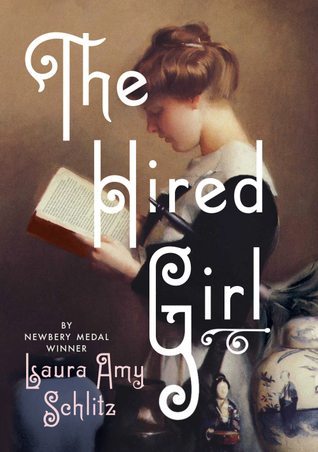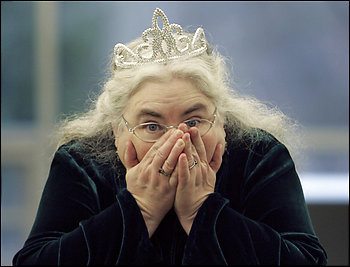Laura Amy Schlitz is an award winning author who specializes in magical historical fiction for young adults and children. Miss Schlitz’s work, though fictional, is known for its feeling of authenticity, but also the feeling of relatability with heart-warming characters who jump off the page. Meet one such character: the driven and charming Joan from Laura’s newest historical YA novel, The Hired Girl, out in bookstores as of September 8th. We were lucky enough to get some time with Miss Schlitz to discuss her new book, her research process, and how she’s just so good at crafting historical characters that feel so relevant in modern times.
Laura is a current resident of Baltimore, MD where she works as a librarian at Park School. According to Miss Schlitz, writing is something she’d always done, but not something she initially pursued. In fact, as a kid, she had quite different aspirations. “When I was a child, I wanted to be a great actress. I wrote a good deal, but I thought of my writing as a pastime: something to amuse me while I was waiting for my real life to begin. I wrote for many years without understanding that someone who wrote all the time was probably a writer.”
Eventually though, Miss Schlitz began to see her writing as something more than a “pastime,” and she made steps toward getting published. She tells us precisely how her first published work came to be: “I was thirty-five, and I had written a light comic romance for adults. My father knew someone whose daughter was a literary agent, so I sent the book to the agent. She sent the book out four times, and the fifth time around, St. Martin’s Press bought it. That was my first novel.”
But after that first initial success, Laura reports feeling a bit discouraged by the publishing process. “It was the second book I couldn’t sell, the one I worked on for four years. It made me think that being published the first time was only a fluke. I loved that book, but I couldn’t sell it, and my agent didn’t think it was worthwhile. I fired my agent and gave up on publishing for five or six years. I went on writing, because it’s a kind of a nasty habit with me. But I didn’t try to sell my work.”
Creative work can often be discouraging, especially if one perceives a lack of positive feedback. Many creatives give up pursuing their dreams for this reason. So as readers, we sure are glad Miss Schlitz stuck with it and continued attempting to get her work published!!! Eventually, Laura made the switch to writing for young people, and a lot of her work is historical in nature. And she’s often praised for her ability to craft very realistic historical stories. What’s her magical secret for crafting these realistic worlds? “Well, first of all, I’m a reader. I read scores of historical novels set in medieval England, Victorian England, and turn-of-the-century America before I ever thought of writing one. I usually try to set a novel in a period I know well. Once I’ve decided on a historical period, I surround myself with books about it. I start with general books about everyday life–I want to know what people ate and wore and where they worked. I seek out primary sources. I buy art books and stare at the pictures. I go to museums and look at artifacts: gondolas, crinolines, ceramics and spoons. I also always have to buy specialist books: a turn-of-the-century kosher cookbook, a book about spiritualism, a book with photographs of Victorian marionettes….I spend a lot of money on books. The Internet is handy, too, especially for academic articles or simple questions like “When was linoleum invented?” But I’m sixty years old; I grew up with books, and I prefer books. What I learn from a printed page seems to stick with me better than what I read on a screen.”
Laura’s most recent novel is The Hired Girl, a novel written in diary format from the perspective of 14 year old Joan in the summer of 1911. Joan leads a simple life cooking a cleaning to make a living in early 20th century Baltimore, but she dreams of so much more. She’s an avid reader and lover of art and culture. She pours her heart out to her diary, dreaming of a life less ordinary and future as more than a hired girl. How did Miss Schlitz first create the character of Joan? “For me, characters don’t usually begin with a single idea. A number of ideas collect, like scattered drops of mercury–or they don’t. I don’t remember in what order the ideas came for The Hired Girl--only that when I started messing around with them, they seemed to fit together in ways that held my attention.”
On Joan’s fictional future after The Hired Girl, Laura says, “She’s very interested in people, so even if she were alive today, she might still be drawn to teaching and writing. I could imagine her as an archaeologist—she loves learning, and there’s a romantic streak in archaeology that might appeal to her. I hope she gets to see Paris someday, but I don’t know whether she will or not. I tend to steer my characters towards a happy destiny, and say good-bye to them–after the book ends, it’s all up to them.”
And did writing in a diary format present any particular challenges? On the contrary, “Diary form was great fun, and much, much easier than writing third-person narrative. To begin with, you can use a conversational tone, so you don’t have to be as meticulous about the shape of the sentences. You can get away with much less description, because your character will only describe those things that greatly interest her. And you can skip around more–if your heroine doesn’t have anything interesting to write about between Monday and Thursday, you can just skip to Thursday. In a novel, you have to find ways of saying to the reader, ‘The next few days passed without incident UNTIL….’ Those transitional passages can be tricky and very tedious to write. In a diary, you can leave them out.”
We asked Miss Schlitz about some of her favorites, literary and otherwise, and not surprisingly her list is populated by many great classic authors including Charles Dickens and Jane Austen. “Great Expectations, The Fountain Overflows, The Song of Lark, Jane Eyre, Madensky Square, Middlemarch, Villete, A Little Princess, and The Brothers Karamazov. I’m nuts about Downton Abbey (of course), but a lot of television feels weak and watered-down–it doesn’t give me the satisfaction that books give me. TV is relaxing, but it’s seldom inspiring.
And what is up next for this accomplished author? “Candlewick Press will be publishing a wonderfully illustrated early reader. I can’t say much about it now, but I’m very excited.”
We’re excited too, Miss Schlitz!! We can’t wait to enter your next magical, historical world!!!



